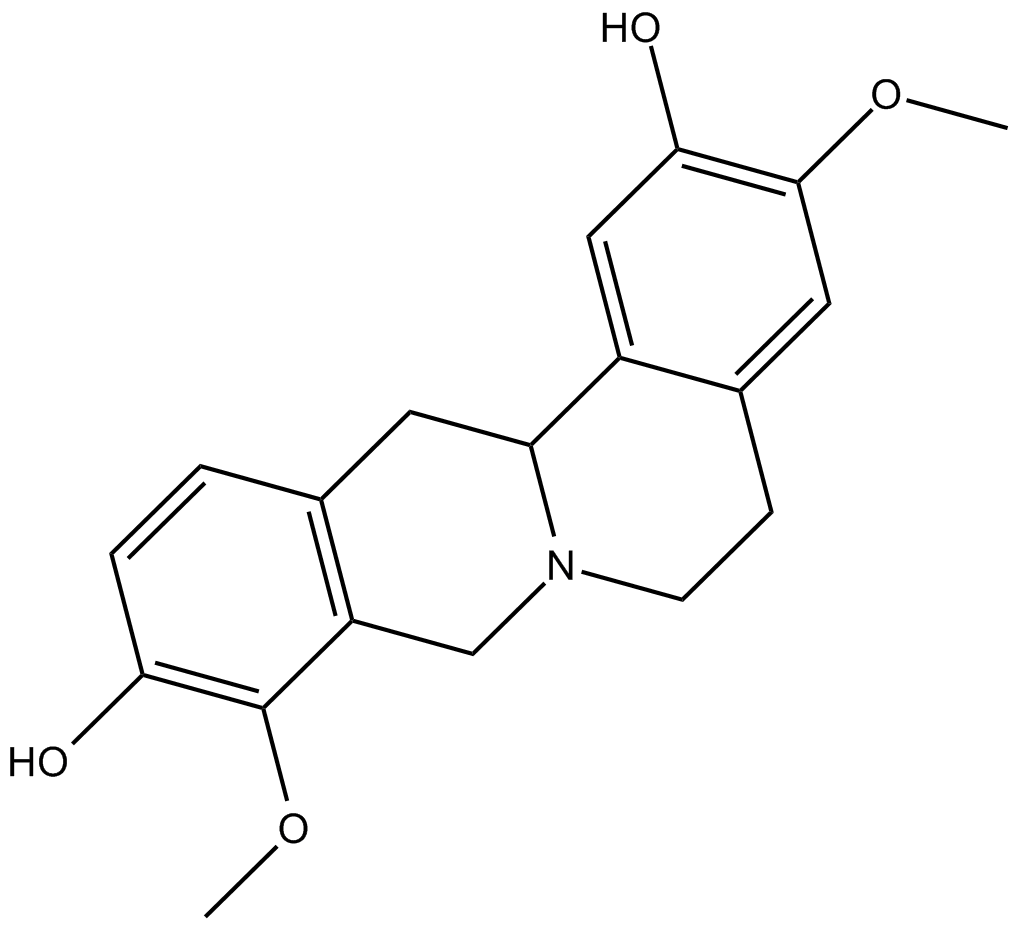(–)-Stepholidine |
| Catalog No.GC14252 |
A dopamine receptor antagonist and 5-HT1A partial agonist
Products are for research use only. Not for human use. We do not sell to patients.

Cas No.: 16562-13-3
Sample solution is provided at 25 µL, 10mM.
(–)-Stepholidine is a dopamine receptor antagonist and a partial agonist of the serotonin (5-HT) receptor subtype 5-HT1A.[1],[2],[3] (–)-Stepholidine binds to dopamine D1, D2, D3, D4, and D5 receptors (Kis = 5.1, 11.6, 24, 1,450, and 5.8 nM, respectively) as well as 5-HT1A, 5-HT2B, α2C-adrenergic receptors (α2C-ARs), and sigma-2 (σ2) receptors in a radioligand binding assay (Kis = 143, 226, 215, and 53 nM, respectively).[1] It inhibits dopamine-induced cAMP accumulation in HEK293 cells expressing dopamine D1, D2, and D5 receptors with IC50 values of 20.5, 128, and 27 nM, respectively. (–)-Stepholidine inhibits forskolin-induced cAMP production in CHO cells expressing rat 5-HT1A receptors (EC50 = 1.2 μM).[2] In vivo, (–)-stepholidine (1 mg/kg, i.v.) increases dopamine neuron firing rates, the number of spikes in bursts, and the amplitude of slow oscillations by 20, 155, and 126%, respectively, in the rat ventral tegmental area (VTA), effects that can be blocked by the 5-HT1A antagonist WAY-100635. [3] Pretreatment with (–)-stepholidine inhibits amphetamine- and phencyclidine-induced locomotor activity in rats (ED50s = 2.4 and 6.5 mg/kg, respectively).[4]
Reference:
[1]. Meade, J.A., Free, R.B., Miller, N.R., et al. (−)-Stepholidine is a potent pan-dopamine receptor antagonist of both G protein- and β-arrestin-mediated signaling. Psychopharmacology 232(5), 917-630 (2015).
[2]. Mo, J., Zhang, H., Yu, L.-P., et al. L-stepholidine reduced L-DOPA-induced dyskinesia in 6-OHDA-lesioned rat model of Parkinson’s disease. Neurobiol. Aging 31(6), 926-936 (2010).
[3]. Gao, M., Chu, H.-Y., Jin, G.-Z., et al. l-Stepholidine-induced excitation of dopamine neurons in rat ventral tegmental area is associated with its 5-HT1A receptor partial agonistic activity. Synapse 65(5), 379-387 (2011).
[4]. Natesan, S., Reckless, G.E., Barlow, K.B.L., et al. The antipsychotic potential of l-stepholidine--a naturally occurring dopamine receptor D1 agonist and D2 antagonist. Psychopharmacology 199(2), 275-289 (2008).
Average Rating: 5 (Based on Reviews and 30 reference(s) in Google Scholar.)
GLPBIO products are for RESEARCH USE ONLY. Please make sure your review or question is research based.
Required fields are marked with *




















